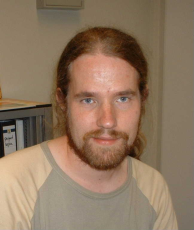Time resolved motion of pulses in photonic crystal waveguides;
a real space investigation
Promotion Date: 25-06-2004
| You got a cum laude with your PhD, congratulations! Well, this is for the first time that you can really see what happens inside photonic crystals, which allows investigation of the physical processes inside the structure. This is a step forward in the work with photonic crystals that started about 17 years ago. The aim was to investigate what happens inside a complex photonic crystal structure. In photonic structures light can be caught or goes through it. It has been investigated how the light goes in and how it comes out, but until this moment you could not tell what exactly happens to the light inside the structure. |
What is your thesis about?
The aim was to investigate what happens inside a complex photonic crystal structure. In photonic structures light can be caught or goes through it. It has been investigated how the light goes in and how it comes out, but until this moment you could not tell what exactly happens to the light inside the structure. I worked on a piece of equipment that makes it possible to do exactly that. The procedure could perhaps be compared with the principle of a mirror, all the light that falls on it is reflected. At the backside of the mirror you therefore won’t see any light. But if you can get very close to the back of the mirror (within 10 to 100 nanometre), so within the wavelength of the light itself, there is an evanescent field which allows you at pinpoint to look inside the structure. The direct visualization of light-pulses in these organized structures is a completely new line of research. But all the in’s and out’s of the research will be publishes shortly.
You got a cum laude with your PhD, your research must have been very important.
Well, this is for the first time that you can really see what happens inside photonic crystals, which allows investigation of the physical processes inside the structure. This is a step forward in the work with photonic crystals that started about 17 years ago.
Why are optical structures so important?
One of the aims is the deployment of optical structures in communication and computing areas. Our present internet connections are established via servers, which are the biggest bottlenecks. At a certain point data gets clogged in the server, because of the switching from optic to electric for incoming data and vice versa for outgoing data. If data handling could be completely optical, an enormous problem is solved and data traffic could be even more than a thousand times quicker. In maybe two or three years the cheap electronic devices will gradually be replaced by the far more expensive, but a great deal more efficient, optical devices. And if you could really understand the behaviour of light and stop or store the light at will for instance in a photonic crystal devices, then all-optical computation will come within reach.
What is it like to get a cum laude?
Well, throughout those 4 years you notice that your work is being appreciated. The satisfaction of having done good work is the gratifying thing for me. Then the promotion itself is only a day.
Did you know it beforehand?
No of course you do not know it. The first suspicion I had that something like that was coming up is when, after my defence, the committee took so much time. They obviously had a firm debate about it.
What did you like best in the past for years?
Getting the chance to really investigate and get at the bottom of things. At a certain point, when you get the feeling that all pieces of the puzzle fall into place is an exhilarating experience.
What are your plans?
On August the 1st I will start to work in Denmark at the University of Århus in the group of Flemming Besenbacher. I was looking for a position in Europe, and I applied in various places, and I like this best. I am going to do similar research, but at an even deeper level with big molecules on a surface, trying to make the interaction between the light and the molecule visible. I am very interested in the processes between matter and light. Before chips can become optical, we have as yet quite a few bridges to cross. I would like to participate in solving the problems. Besides, Denmark is an excellent country for my Polish wife, who can get a job in Denmark if she wants - as opposed to many other countries. And it is a very good environment for my two small children who can play in a garden and get far more living space than they have now.

